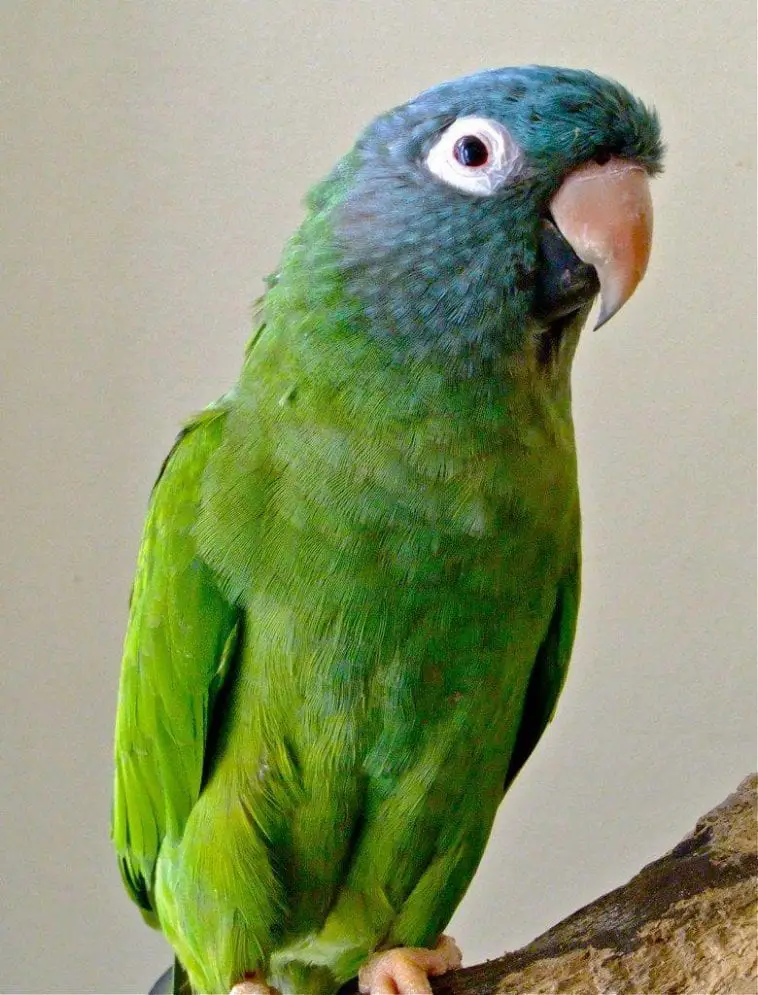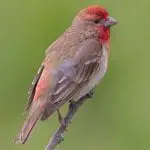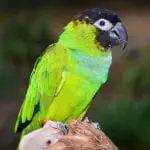Scientific Facts
| Common Name | Blue-crowned Conure |
| Scientific Name | Thectocercus acuticaudatus |
| Origin | South America from northern Argentina in the south and eastern Colombia in the north |
| Habitat | savanna-like habitats, forest margins, and woodland. A perfect place is the humid forest of Amazon |
| Diet | fruits and seeds found on the trees where they stay |
| Size and Weight | Size: 15.5 in (37 cm) in length Weight: 140 to 190 g (4.9 and 6.7 oz) |
| Life Span | 25 to 30 years |
Physical Description
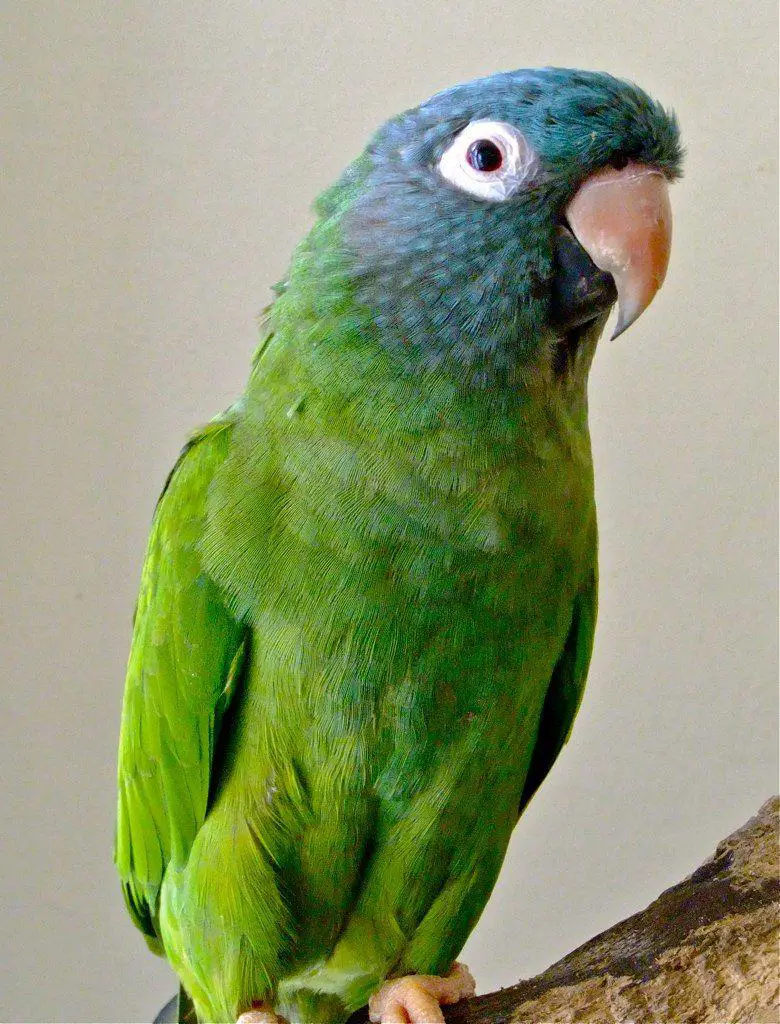
The blue-crowned parakeet, blue-crowned conure, or sharp-tailed conure is characterized by its predominantly color green small body with a blue crown and pale beak. It has a dull blue coloration on its cheeks, forehead, and ears. It is easily distinguished by its featherless skin around the eye area with a ring of white; some say it is orange-yellow in the wild its breast feathers have hints of blue, but they are more perceived that has green to yellow-green colorations.
When the wings are closed, its color matches the overall color if the body because it has green to yellow-green colorations. Its tail has maroon to brown colorations on the sides while green colors on top of their tails. The legs and feet are pinkish browns. During their juvenile years, they have a dominant reddish coloration, but this color changes when they reach maturity. The males have a larger ring eyepatch than the females, and their feathers are longer than females.
Where it is Seen?
They are native to South America from northern Argentina in the south and eastern Colombia in the north.
Habitat
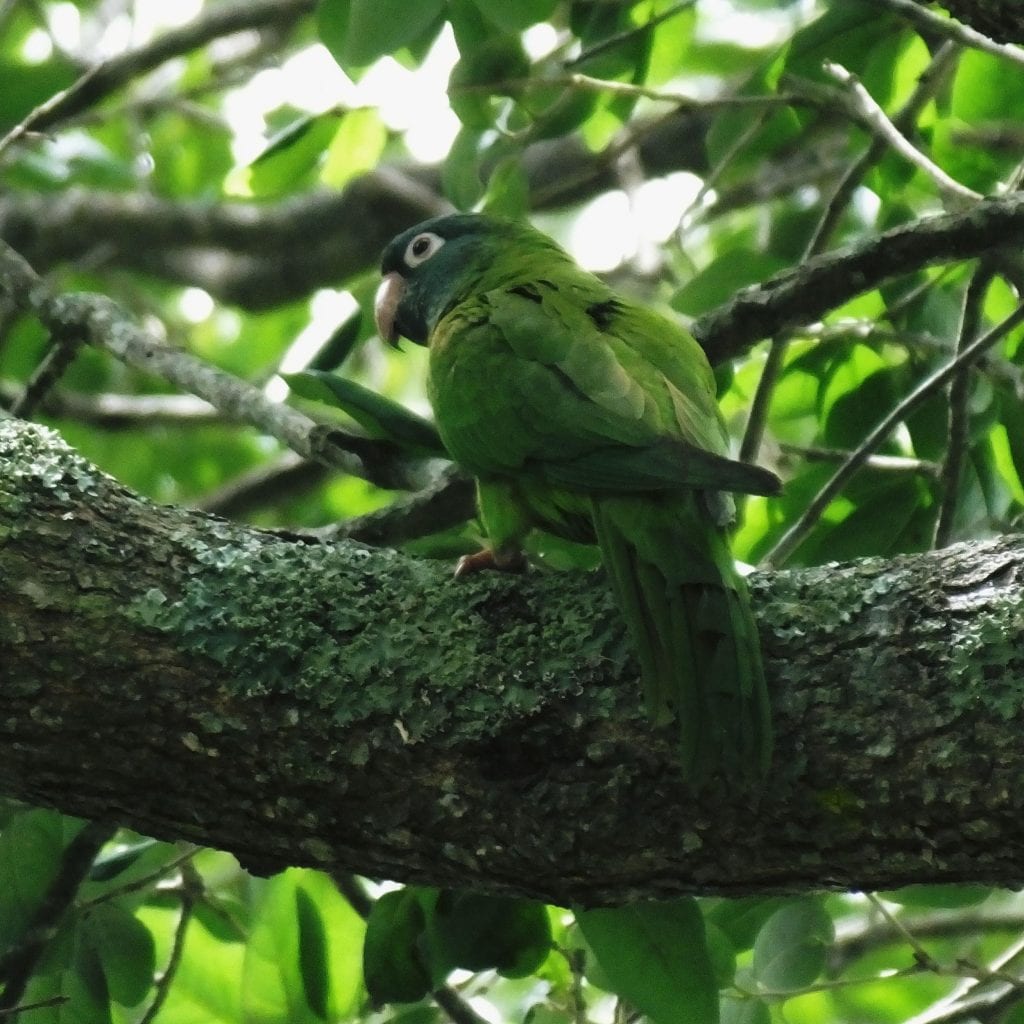
The blue-crowned conure thrives in savanna-like habitats, forest margins, and woodland. A perfect place is the humid forest of Amazon.
Behavior and Temperament
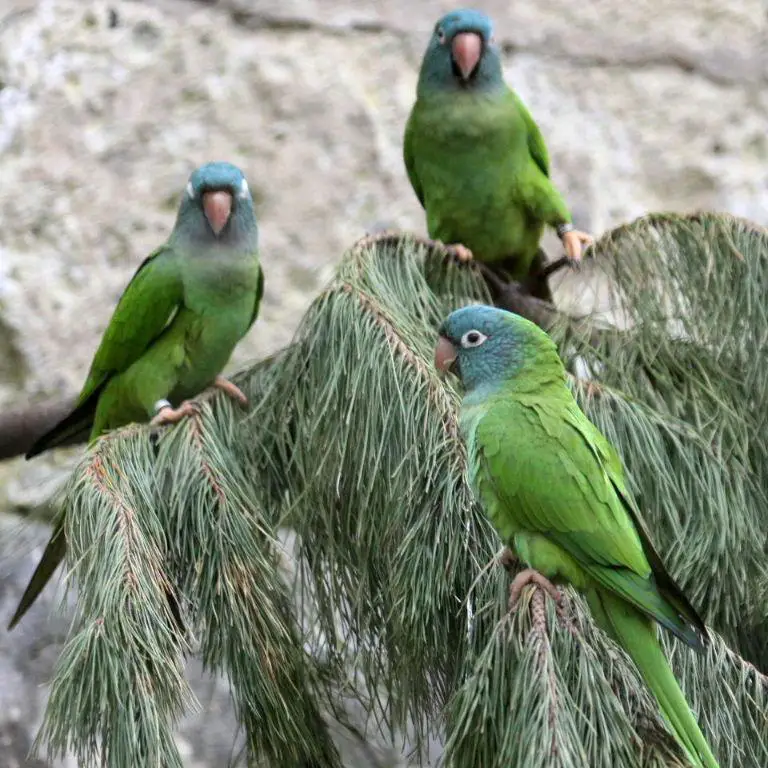
Blue-crowned conures are social birds that are described as a good talker compared to other conures. They are intelligent and full of energy, but they have a need for companionship, especially if they are in captivity where they require attention from humans when they are all alone. They rarely bite; that is why they are a suitable pet for captivity. They are regarded as one of the quieter conures but expect that they’ll create noise in the morning and in the evening
Breeding and Reproduction
The blue-crowned conures are sexually active when they reach the age of 4. They are known to be monogamous birds that have a pair that mate for life. The females have the ability to lay about three to four white eggs will be incubated for about 26 days. It is the male’s responsibility to feed for the females as well as their offspring until the chicks are ready to fledge 55 days after the hatching period.
Diet
They are not a picky eater, but in the wild, they would usually feed on fruits and seeds found on the trees where they stay.
Size and Weight
The blue-crowned conure is a medium-sized bird measuring approximately (15.5 in) 37 cm in length and weighing between 140 and 190 g (4.9 and 6.7 oz). The size of their wings is about 3 – 5.8 oz.
Lifespan
The blue-crowned conure has about 25 to 30 years of lifespan in captivity. Expect those who stay in the wild has a shortened lifespan due to several reasons. In captivity, as long as they receive the proper care and guidance, they’ll achieve their maximum life span.
Common Diseases/Illnesses
Overweight parrot
This happens when your bird has an oversupply or lack of a certain nutrient. The blue-crowned conure is a medium-sized bird; if they are too heavy, there is a possibility that they will have difficulty in doing their daily activities, which are not healthy. The sugary and fatty-based diet. They are more prone to obesity when they are taken in captivity because they have a limited exercise, and sometimes, they are given an incorrect diet. Overweight is linked to obesity that triggers other diseases such as liver disease, diabetes, liver disease, and heart ailments.
Avian Gastric Yeast (AGY) infection (megabacteriosis)
This is a common bacterial infection caused by yeast that directly affects the digestive system of the bird. There is a possibility that they’ ll lose weight immediately due to the inability to digest food. There are no symptoms if these diseases, aside from weight loss, that is why it is quite difficult to determine. A sign that your pet suffers this disease if their feces has undigested food.
Aspergillus
This is a respiratory illness for parrots, where the fungal infection affects the functioning of the lungs and air sacs. It is usually acquired through damp and dirty environmental conditions where different kinds of bacteria already flourished. As a manifestation, your parrot may show signs of difficulty in breathing with audible wheezing and mucus discharge in their nostrils.
Nutritional Deficiencies
When your parrot lacks certain nutritional deficiency, that effects may be visible physically, such as malformation and dullness in the coloration of their feathers, feather loss, and sometimes change in their behavior. Most of the common nutritional deficiency is the Hypocalcaemia or lack of calcium. If a female is infected with Hypocalcemia, its eggs will be affected because it will produce an egg product which has soft shells that can break easily. There are free particular diet plans for parrots to avoid any deficiency.
Candida virus (Thrush), or Candidiasis
This is commonly due to yeast infection that directly targets the digestive tract of the parrot. It is highly transmissible to humans. Your parrot’s experiemucuscous discharge, wheezing, colds, and swollen eyes. It can be treated with antibiotics; that is why your parrot needs to be taken into the nearest veterinary.
Macaw Wasting Syndrome, or Proventricular Dilatation syndrome
This disease targets the stomach that will have difficulty in digesting the food that leads to weight loss. Their droppings have undigested food ad evidence. Your bird needs to undergo antibiotic treatment for a week; if not attended to immediately, it could be fatal because of the inability of their body to absorb nutrients.
Polyoma
The common symptoms of this disease to birds include paralysis, tremors, hemorrhages, lethargic, and diarrhea. There’s still no cure, medication, and vaccination to this disease. Therefore, if you’re planning to buy a parrot, make sure that your bird doesn’t have any diseases and start having your pet to have a test to detect easily if your pet has polyoma or is a carrier of polyomavirus. Quarantine and testing can help prevent polyoma from entering a breeding area.
Psittacine Beak and Feather Disease (PBFD)
This is what happens when the immune system of the parrot is low that it can no longer protect its body from different damaging environmental factors. It is not fatal, but it would affect the overall beauty of the parrot and other people who would see that they would perceive that they have a transmittable disease affecting the way how they are handled. There are ointments prescribed to avoid the feather to further drop because feathers are the number 1 barrier against infections.
Parrot Fever, or Psittacosis
This is considered as the worst disease or illness a parrot can get because once it strikes, it may spread quickly and may cause affected parrots to die. The bacteria responsible for this is a fatal disease is the Chlamydophila psittaci. It should be treated immediately through the use of antibiotics.
Ulcerative dermatitis
This is a disease that brings irritability to the parrot. The bacteria and fungi cause the skin to have wounds and breakage. The parrot feels itchiness and stinging sensations; that is why they further peck their skin, worsening their skin’s condition. When you see that your parrot has an open wound, make sure to do first aid so that it won’t be infected.
Preventing Illnesses
Some reasons why the blue-crowned conure acquires diseases or illnesses because of some reasons such as unsanitary environment, nutritional deficiency, boredom, stress, and incorrect way of handling. There is a certain way on how to take good care of them, that is why before taking them in captivity, equipped yourselves with knowledge on how to make them happy and healthy.
As soon as this bird feels something wrong with their body, for sure, they’ll act strange, so be keen on detecting if your pet is not feeling well. There are more diseases that are acquired in the wild; that is why, before taking them in captivity, make sure that they are quarantined to ensure that they are 100% healthy.
Captive Breeding
Blue-crowned conures are aviculture wherein they are a popular bird species to be captive-bred. However, this is not the type of conure species that you can just leave; they are highly sociable; that is why you need to create an environment that will not make them bored and stressed. It is advisable to just take them in pairs, so decorating their cage with toys won’t be too much of a hassle because having a companion is better for them to relieve boredom.
Availability-Where to Get One?
The blue-crowned conures are one of the conure species that are almost readily available for sale in large pet stores, as well as from bird breeders or even in avian specialty stores.
How to Care Parrot as a Pet
Housing
The blue-crowned conures are not contented to just stay in their cage and do nothing; they also need human interaction; that is why situating their cage in a place where they see people will somehow give them the illusion that they are in a flock. Since they are a medium-sized bird, they should be given a spacious cage where they can move freely together with different accessories such as toys and perches. The suitable cage dimensions for them is about 5” W x 6” H x 3½” ft D. The appropriate cage that you must choose should be a square-shaped or rectangular-shaped cage because if a round-shaped caged were used, there is a possibility that the bird will feel unsafe that will trigger their aggressiveness.
Accessories
If you do not have the time to give them the human interaction that they need, a better way to deal with it is through the use of toys to help out the emotional health of the bird. Placing perches is also a great exercise for them. Chewing is one of their greatest past times si make sure that the toys in their cage are somehow chewable.
Feeding
In captivity, it is a must to give your bird with a nutritionally balanced diet, which can be found in pelleted foods for them together with some supplemental foods such as fruits and vegetables. Feed them regularly at the same time regularly.
Grooming
These bird species love to bathe regularly. You must bathe them at least weekly. Bathing will not only keep them fresh, but it is important in ensuring that their skin is always healthy free from parasites.
Conservation Status
There are no problems in population, whether in the wild or in captivity, but as early as now, destructive methods that threats their population, such as illegal hunting is no longer prohibited and are punishable.
FAQ Section
Do blue-crowned conures need a lot of attention?
They seek attention when they get bored; that is why you need to provide them an environment where the feelings of boredom and stress are diverted. They need a lot of attention, especially in captivity, so if time permits, play with them at least an hour daily.
How to distinguish if my blue-crowned conures is a female or male?
There are some physical differences, but experts say that it is not reliable, so DNA testing will give you more reliable results regarding the gender of your bird.
Do blue-crowned conures love their owners?
They are highly affectionate; that is why they need someone who will take good care of them and whom will they love in return. They have the ability to distinguish their owners, especially through feeding sessions.
What do blue-crowned conures noises mean?
Blue-crowned conures produce several loud calls, especially when they are bored and stressed. This bird species are known to create noise early in the morning and at night time.
Why do blue-crowned conures bob their heads?
Head bobbing is normal. For males, they do this as a mating dance while bobbing their head up and down while climbing at the highest point of their cage.
Are blue-crowned conures aggressive?
Blue-crowned conures are not aggressive, and they do not bite unless they are provoked where they act aggressively as a defense mechanism.
Do blue-crowned conures do better in pairs?
Yes. They have the need for socialization. Take them in pairs if you do not have the ability to devote your time to regularly interact with them.

